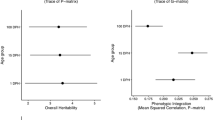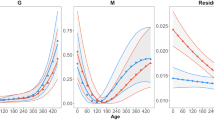Summary
We examined heritabilities and correlations among measures of locomotor performance (speed, stamina) and among possible morphometric determinants of performance (hindlimb span, tail length) in families of hatchling lizards (Sceloporus occidentalis). We were particularly interested in determining whether these traits were heritable and thus might potentially respond genetically to selection. Moreover, we wished to determine whether speed and stamina are negatively genetically correlated, as suggested bya priori physiological and empirical considerations. All four traits appeared to be significantly heritable. Broadsense heritabilities were 0.33–0.36 for speed, 0.35–0.36 for stamina, 0.45–0.51 for hindlimb span, and 0.46–0.47 for tail length. Contrary to expectations, speed and stamina were not negatively genetically correlated. Hindlimb span and tail length, however, were negatively genetically correlated (but not phenotypically correlated). Hindlimb span and stamina were positively phenotypically correlated. Thus, for example, selection for longer hindlimb span could potentially result in shorter tails, contrary to evolutionary predictions based only on phenotypic correlations.
Similar content being viewed by others
References
Arnold, S. J. (1981a) Behavioral variation in natural populations. I. Phenotypic, genetic and environmental correlations between chemoreceptive responses to prey in the garter snake,Thamnophis elegans.Evolution 35, 489–509.
Arnold, S. J. (1981b) Behavioral variation in natural populations. II. The inheritance of a feeding response in crosses between geographic races of the garter snake,Thamnophis elegans.Evolution 35, 510–15.
Arnold, S. J. (1981c) The microevolution of feeding behavior.Foraging Behaviour: Ecological Ethological and Psychological Approaches. A. Kamil and T. Sargent (eds), pp 409–53. Garland Press, New York, USA.
Arnold, S. J. (1983) Morphology, performance and fitness.Amer. Zool. 23, 347–61.
Arnold, S. J. (1986) Laboratory and field approaches to the study of adaptation.Predator-Prey Relationships: Perspectives and Approaches from the Study of Lower Vertebrates. M. E. Feder and G. V. Lauder (eds), pp 157–79. University of Chicago Press, Chicago, IL, USA.
Arnold S. J. (1987) Genetic correlation and the evolution of physiology.New Directions in Ecological Physiology. M. E. Feder, A. F. Bennett, W. Burggren and R. B. Huey (eds), pp. 189–215. Cambridge University Press, Cambridge, UK.
Arnold, S. J. and Bennett, A. F. (1984) Behavioral variation in natural populations. III. Antipredator displays in the garter snakeThamnophis radix.Anim. Behav. 32, 1108–18.
Arnold, S. J. and Bennett, A. F. (1988) Behavioral variation in natural populations. V. Morphological correlates of locomotion in the garter snake,Thamnophis radix.Biol. J. Linn. Soc. 34, 175–190.
Bennett, A. F., (1980a) The thermal dependence of lizard behaviour.Anim. Behav. 28, 752–62.
Bennett, A. F. (1980b) The metabolic foundations of vertebrate behavior.Bioscience 30, 452–6.
Boag, P. T. (1983) The heritability of external morphology in Darwin's ground, finches (Geospiza) on Isla Daphne Major, Galapagos.Evolution 37, 877–94.
Bulmer, M. (1980)The Mathematical Theory of Quantitative Genetics. Clarendon Press, Oxford, UK.
Christian, K. C. and Tracy, C. R. (1981) The effect of the thermal environment on the ability of hatchling Galapagos land iguanas to avoid predation during dispersal.Oecologia 49, 218–23.
Conover, W. J., Johnson, M. E. and Johnson, M. M. (1981) A comparative study of tests for homogeneity of variances, with applications to the outer continental shelf bidding data.Technometrics 23, 351–61.
Darwin, C. (1868)The Variation of Animals and Plants under Domestication. John Murray, London, UK.
Falconer, D. S. (1981)Introduction to Quantitative Genetics, 2nd edn. Longman, London, UK.
Gaffney, B. and Cunningham, E. P. (1988) Estimation of genetic trend in racing performance of thoroughbred horses.Nature 332, 722–4.
Gans, C. (1986) Locomotion of limbless vertebrates: pattern and evolution.Herpetologica 42, 33–46.
Garland, T., Jr (1984) Physiological correlates of locomotory performance in a lizard: An allometric approach.Amer. J. Physiol. 247 (Reg. Integ. Comp. Physiol. 16), R806-R815.
Garland, T., Jr (1985) Ontogenetic and individual variation in size, shape, and speed in the Australian agamid lizardAmphibolurus nuchalis.J. Zool. (Lond.) (A)207, 425–39.
Garland, T., Jr (1988) Genetic basis of activity metabolism. I. Inheritance of speed, stamina, and antipredator displays in the garter snakeThamnophis sirtalis.Evolution 42, 335–50.
Garland, T., Jr and Else, P. (1987) Seasonal sexual, and individual variation in endurance and activity metabolism in lizards.Amer. J. Physiol. 252, (Reg. Integ. Comp. Physiol. 21), R439-R449.
Gibbs, H. L. (1988) Heritability and selection on clutch size in Darwin's Medium Ground Finches (Geospiza fortis).Evolution 42, 750–62.
Greenwald, O. E. (1974) Thermal dependence of striking and prey capture by gopher snakes.Copeia 1974, 141–8.
Hailman, J. P. (1986) The heritability concept applied to wild birds.Current Ornithology Vol. 4. R. F. Johnston (ed), pp. 71–95. Plenum Press, New York, USA
Heinrich, B. (1985) Men vs. women, marathoners vs. ultramarathoners.Ultrarunning 1985, 16–18.
Hill, W. G. (1988) Why aren't horses faster?Nature 332, 678.
Hintz, R. L. (1980) Genetics of performance in the horse.J. Anim. Sci. 51, 582–94.
Huey, R. B. and Hertz, P. E. (1984) Is a jack-of-all-temperatures a master of none?Evolution 38, 441–4.
Huey, R. B., and Stevenson, R. D. (1979) Integrating thermal physiology and ecology of ectotherms: A discussion of approaches.Amer. Zool. 19, 357–66.
Huey, R. B., Schneider, W., Erie, G. L. and Stevenson, R. D. (1981) A field-portable racetrack and timer for measuring acceleration and speed of small cursorial animals.Experientia 37, 1356–7.
Huey, R. B., Bennett, A. F., John-Alder, H. B. and Nagy, K. A. (1984) Locomotor capacity and foraging behavior of Kalahari lacertid lizards.Anim. Behav. 32, 41–50.
Lande, R. (1979) Quantitative genetic analysis of multivariate evolution, applied to brain:body size allometry.Evolution 33, 402–16.
Lande, R. and Arnold, S. J. (1983) The measurement of selection on correlated characters.Evolution 37, 1210–26.
Langlois, B. (1980) Heritability, of racing ability in thoroughbreds — a review.Livestock Prod. Sci. 7, 591–605.
Lessells, C. M. and Boag, P. T. (1987) Unrepeatable repeatabilities: A common mistake.Auk 104, 116–21.
MacMahon, T. A. (1984)Muscles, Reflexes and Locomotion. Princeton University Press, Princeton New Jersey, USA, 331 pp.
Mitchell-Olds, T. and Rutledge, J. J. (1986) Quantitative genetics in natural plant populations: A review of the theory.Amer. Natur. 127, 379–402.
Mousseau, T. A. and Roff, D. A. (1987) Natural selection and the heritability of fitness components.Heredity 59, 181–97.
Norusis, M. J. (1986)SPSS/PC+ for the IMB PC/XT/AT, SPSS, Inc., Chicago, IL, USA.
Ojala, M. J. and Van Vleck, L. D. (1981) Measures of a racetrack performance with regard to breeding evaluation of trotters.J. Anim. Sci. 53, 611–19.
Ryan, J. E. (1975)The Inheritance of Track Performance in Greyhounds. MA Thesis, Trinity College, Dublin, Ireland.
Seigel, R. A., Collins, J. T. and Novak, S. S. (eds) (1987)Snakes: Ecology and Evolutionary Biology. Macmillan, New York, USA, 529 pp.
Shaw, R. G., (1987) Maximum likelihood approaches applied to quantitative genetics of natural populations.Evolution 41, 812–26.
Slinker, B. K. and Glantz, S. A. (1985) Multiple regression for physiological data analysis: The problem of multicollinearity.Am. J. Physiol. 249 (Reg. Integ. Comp. Physiol. 18), R1-R12.
Snell, H. L., Jennings, R. D., Snell, H. M. and Harcourt, S. (1988). Intrapopulation variation in predatoravoidance performance of Galapagos lava lizards: The interaction of sexual and natural selection.Evol. Ecol. 2, 353–369.
Sokal, R. R. and Rohlf, F. J. (1981)Biometry. W. H. Freemann & Company, San Francisco, California, 781 pp.
Stearns, S. C. (1984) Heritability estimates for age and length at maturity in two populations of mosquitofish that shared ancestors in 1905.Evolution.38, 368–75.
Tolley, E. A., Notter, D. R. and Marlowe, T. J. (1983) Heritability and repeatability of speed for 2- and 3-year-old standardbred racehorses.J. Anim. Sci 56, 1294–1305.
Tracy, C. R., Packard, G. C. and Packard, M. J. (1978) Water relations of chelonian eggs.Physiol. Zool. 51, 378–87.
Tsuji, J. S. (1986)Metabolic Adaptations to Temperature in Lizards of the Genus Sceloporus,from Different Latitudes. PhD Dissertation, University of Washington, Seattle, Washington, USA, 103 pp.
van Berkum, F. H. (1988) Latitudinal patterns of the thermal sensitivity of sprint speed in lizards.Am. Natur. 132, 327–43.
van Berkum, F. H. and Tsuji, J. S. (1987) Inter-familial differences, in sprint speed of hatchling lizards (Sceloporus occidentalis).J. Zool. (Lond.)212, 511–19.
van Berkum, F. H., Huey, R. B., Tsuji, J. S. and Garland, T. Jr (1989) Repeatability of individual differences in locomotor performance and body size during early ontogeny of the lizardSceloporus occidentalis.Func. Ecol. 3, 97.
Webb, P. W., (1986) Locomotion and predator-prey relationships.Predator-Prey, Relationships: Perspectives and Approaches from the Study of Lower Vertebrates. M. E. Feder and G. V. Lauder (eds) pp 24–41, University of Chicago Press, Chicago, IL, USA.
Author information
Authors and Affiliations
Rights and permissions
About this article
Cite this article
Tsuji, J.S., Huey, R.B., van Berkum, F.H. et al. Locomotor performance of hatchling fence lizards (Sceloporus occidentalis): Quantitative genetics and morphometric correlates. Evol Ecol 3, 240–252 (1989). https://doi.org/10.1007/BF02270725
Issue Date:
DOI: https://doi.org/10.1007/BF02270725




